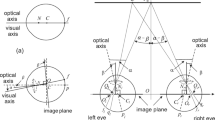Abstract
Visual function of lens accommodation was measured while subjects used stereoscopic vision in a head mounted display (HMD). Eyesight with stereoscopic Landolt ring images displayed on HMD was also studied. In addition, the recognized size of virtual stereoscopic images was estimated using the HMD. Accommodation to virtual objects was seen when subjects viewed stereoscopic images of 3D computer graphics, but not when the images were displayed without appropriate binocular parallax. This suggests that stereoscopic moving images on HMD induced the visual accommodation. Accommodation should be adjusted to the position of virtual stereoscopic images induced by parallax. The difference in the distances of the focused display and stereoscopic image may cause visual load. However, an experiment showed that Landolt rings of almost the same size were distinguished regardless of virtual distance of 3D images if the parallax was not larger than the fusional upper limit. However, congruent figures that were simply shifted to cause parallax were seen to be larger as the distance to the virtual image became longer. The results of this study suggest that stereoscopic moving images on HMD induced the visual accommodation by expansion and contraction of the ciliary muscle, which was synchronized with convergence. Appropriate parallax of stereoscopic vision should not reduce the visibility of stereoscopic virtual objects. The recognized size of the stereoscopic images was influenced by the distance of the virtual image from display.
Chapter PDF
Similar content being viewed by others
References
Hasegawa, S., Omori, M., Watanabe, T., Fujikake, K., Miyao, M.: Lens Accommodation to the Stereoscopic Vision on HMD. In: Shumaker, R. (ed.) VMR 2009. LNCS, vol. 5622, pp. 439–444. Springer, Heidelberg (2009)
Omori, M., Hasegawa, S., Watanabe, T., Fujikake, K., Miyao, M.: Comparison of measurement of accommodation between LCD and CRT at the stereoscopic vision gaze. In: Shumaker, R. (ed.) VMR 2009. LNCS, vol. 5622, pp. 90–96. Springer, Heidelberg (2009)
Miyao, M., Otake, Y., Ishihara, S.: A newly developed device to measure objective amplitude of accommodation and papillary response in both binocular and natural viewing conditions. Jpn. J. Ind. Health 34, 148–149 (1992)
Miyao, M., Ishihara, S., Saito, S., Kondo, T., Sakakibara, H., Toyoshima, H.: Visual accommodation and subject performance during a stereographic object task using liquid crystal shutters. Ergonomics 39(11), 1294–1309 (1996)
Omori, M., Hasegawa, S., Ishigaki, H., Watanabe, T., Miyao, M., Tahara, H.: Accommodative load for stereoscopic displays. In: Proc. SPIE, vol. 5664, p. 64 (2005)
Hori, H., Shiomi, T., Kanda, T., Hasegawa, A., Ishio, H., Matsuura, Y., Omori, M., Takada, H., Hasegawa, H., Miyao, M.: Comparison of accommodation and convergence by simultaneous measurements during 2D and 3D vision gaze. In: HCII 2011. LNCS, vol. 6773. Springer, Heidelberg (2011)
Author information
Authors and Affiliations
Editor information
Editors and Affiliations
Rights and permissions
Copyright information
© 2011 Springer-Verlag Berlin Heidelberg
About this paper
Cite this paper
Hasegawa, S., Hasegawa, A., Omori, M., Ishio, H., Takada, H., Miyao, M. (2011). Stereoscopic Vision Induced by Parallax Images on HMD and Its Influence on Visual Functions. In: Shumaker, R. (eds) Virtual and Mixed Reality - New Trends. VMR 2011. Lecture Notes in Computer Science, vol 6773. Springer, Berlin, Heidelberg. https://doi.org/10.1007/978-3-642-22021-0_33
Download citation
DOI: https://doi.org/10.1007/978-3-642-22021-0_33
Publisher Name: Springer, Berlin, Heidelberg
Print ISBN: 978-3-642-22020-3
Online ISBN: 978-3-642-22021-0
eBook Packages: Computer ScienceComputer Science (R0)




